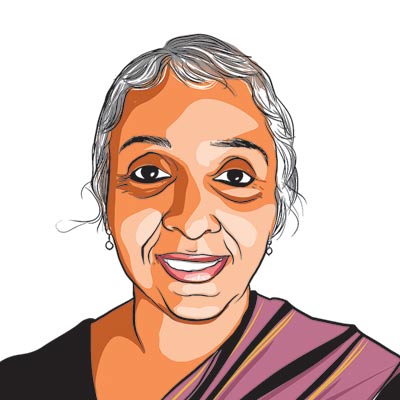Opinion Dabbling In Doublespeak
Media is the new battleground in the conflict zone

 Security forces trying to control the mob in Kashmir valley
Security forces trying to control the mob in Kashmir valley
The conflict zones that mark various corners of India are spilling on to new territory — spaces that are ideologically, not geographically, defined. The media have become the new battleground. The hostilities that mark the first are now allowed to freely play out within the second as mobile phones go immobile, the internet gets netted, police personnel turn up at the doors of media houses and media personnel, forced to turn up at the doors of police stations.
Consider these facts. In the Kashmir Valley, images in searing close-up of the tattoos security personnel perpetrated through their 12 bore pellet guns on the faces of children had so unnerved the authorities that newspapers across the Valley were banned for three days. The move, ostensibly ordered by lowly police officers, came wrapped in such a patina of deniability that the Jammu and Kashmir chief minister could later claim that there was in fact no ban.
The imprecations of such Orwellian doublespeak played out in Nagaland last November when the Assam Rifles issued an ultimatum to the editors of the state that publishing any article that “projects the demands of NSCN (K) and gives it publicity is a violation under the Unlawful Activities (Prevention) Act 1967, and should not be published.” Three local newspapers, which have long walked the thin line between pressures of the NSCN (K) militants and the Indian army, chose to respond by coming out with blank editorials.
Meanwhile Chhattisgarh’s democratically elected government is fast becoming an Orwellian state. Over the years it has created conditions that render independent investigation impossible in a region urgently in need of public scrutiny. Those seeking to investigate the rapacious ways of the forest and mining mafias, the impunity of the police, or the complexities of insurgency, have had to protect themselves not just from Maoists dissatisfied with their reportage and willing to kill them as agents of the state, but from a police force protected by the Chhattisgarh Special Public Security Act, 2005, and equally willing to make their lives uncomfortable for not being agents of the state. They could end up behind bars for indefinite spells of time; get hounded out of the area, or come a cropper against an impenetrable system of state-imposed secrecy.
These are just three instances where turning off media lights has only led to conflict spiralling out of control. The media today have become a major instrument in strategies to gain political legitimacy and exercise power. With new communication technologies providing an added efficiency to this process, conflict has increasingly become mediatised.
Evidence of such mediatised conflict, on both sides of the divide, abound. The rash of Facebook pages that came up in 2010, after stone pelting incidents had paralysed the Valley, was one instance. To take another example, you have the Chhattisgarh police cultivating through extensive patronage a phalanx of “friendly journalists” whose main task was to project the government and its security apparatus in a favourable light. In order to control mediatised conflict, it also took to mediatised repression, helping to set up the Bastar-based Samajik Ekta Manch to terrorise individual journalists. So notorious was its functioning that it was recently disbanded after public and media outrage.
Turning the media into an adjunct of the conflict zone will not help the state counter the violence it faces; that would require credible politics and enlightened leadership. All that instrumentalisation of the media will achieve is to strip the institution of its symbolic value and its potential to enhance communication between people, even those situated across conflict lines. What is disturbing, though, is the passivity with which we, who constitute the larger public, accept these cynical manoeuvres. Imprisoned in a vortex of misinformation; tantalised by rumours bouncing off Facebook walls; lulled by the interminable “Us versus Them” narrative of corporatised, state-endorsed mainstream television platforms, are we losing the urge to question; the capacity to intervene?
The writer is a senior journalist





